9 Best Compact Binoculars of 2025 – Top Picks & Reviews
Last Updated on
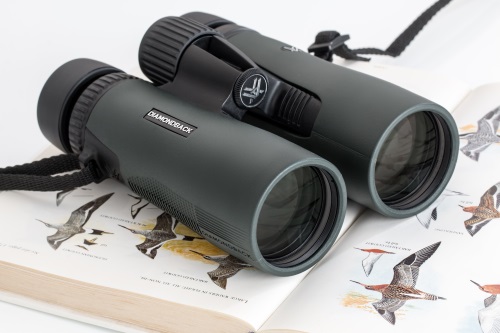
Having the right set of binoculars isn’t always a matter of viewing power. If you’re moving around and have to concern yourself with weight, you may be willing to sacrifice some image quality so your binoculars aren’t a drag on you.
Finding the right set can be difficult. There are a lot of different models available and optics tend to be heavy on jargon that most people aren’t familiar with. So, we wrote these reviews of some of the compact binoculars you’re apt to run across while shopping. We included a quick buyers’ guide at the bottom that breaks down some of the basic features of every set of binoculars. We think that if you’re interested in buying any kind of binoculars it’s a worthwhile, informative read.

Comparison of our Favorites (Updated in 2025)
| Image | Product | Details | ||
|---|---|---|---|---|
| Best Overall |
 |
Zeiss Terra 8×25 |
|
CHECK PRICE |
| Best for Hunting |
 |
Vortex Diamondback |
|
CHECK PRICE |
 |
Nikon PROSTAFF 7S |
|
CHECK PRICE | |
| Best Value |
 |
Bushnell H20 |
|
CHECK PRICE |
 |
Celestron 71406 |
|
CHECK PRICE |
The 9 Best Compact Binoculars
1. Zeiss Terra 8×25 Compact Binoculars – Best Overall
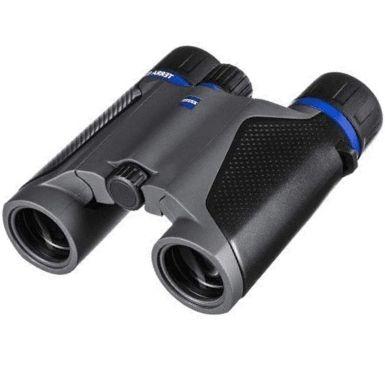
If you want to know what to look for in some of the best small and lightweight binoculars for birding, hiking, backpacking, and more, take a close look at what the Zeiss 8×25 Terra ED Compact Pocket binoculars offer. It got our Top Pick because it packs optimal performance into a lightweight frame that you can carry all day without getting fatigued.
Your top priority with any binoculars is the imaging, and the Zeiss 8×25 multi-coated lenses made from extra-low dispersion glass produce crystal clear images without any color blurring. The body is weatherproofed to operate in extreme temperatures and through any kind of exposure to moisture, from merely humid air to torrential downpours. They’re also easy-to-adjust and fold down into a compact case and weighs just over a pound.
The one thing you might not like about these is the price. These are very expensive compared to the other binoculars we reviewed. But if you’re willing to spend the money, these are a great investment and the best compact binoculars you can buy.
- Sharp images
- Clear color
- Weatherproof
- Very portable
- Easy to use
- Expensive
2. Vortex Diamondback Compact Binocular – Best for Hunting
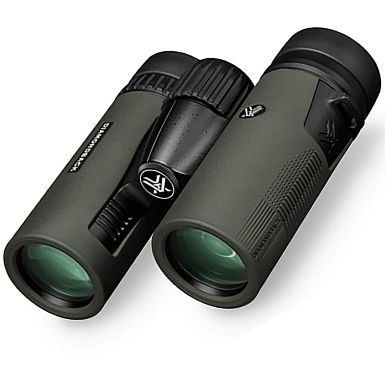
Binoculars made for hunting tend to be a bit bigger, because they need to produce sharp images of animals at slightly longer ranges. Vortex makes some of the best hunting binoculars, and the Diamondback Compact is good enough that it got our nod for best compact binoculars for hunting.
These are overall just a pleasure to use. They deliver sharp, clear images courtesy their coated lenses and high-grade prisms. The frame is durable and made of non-slip hardened rubber that won’t let water in and won’t slip from your hands when wet. They’re also lightweight and compact for on-the-go use.
Our only complaint is that the Diamondback is designed for hunting, which means they’re a little bigger than a set of everyday binoculars for uses like backpacking and birding. If you need the range, these are close to perfect. If you need an everyday set, there are others more suitable.
- Superb imaging
- Rugged
- Fully waterproof
- Lightweight
- Only great at one thing
3. Nikon PROSTAFF 7S Compact Binoculars
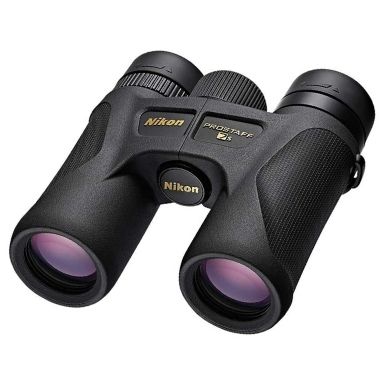
When it comes to images, the name Nikon is as good as gold. They bring the same excellence of their cameras to their binoculars, and their 16000 PROSTAFF 7S are one of the best sets of compact binoculars available.
They’ve incorporated the latest advances in optics to deliver a top-notch product. Their rubber armor coating is comfortable to hold and these binoculars won’t slip from your hands. They are built to take a beating, either from physical shocks to immersion in water.
While they’re great for birding, the imaging could be a bit better. What you see is just very good. There is nothing wrong with that, but there are other models that excel at imaging.
- Good images
- Robust design
- Great for birdwatching
- Comfortable to hold
- Expensive
- Merely very good optics
4. Bushnell H20 Compact Binoculars – Best Value
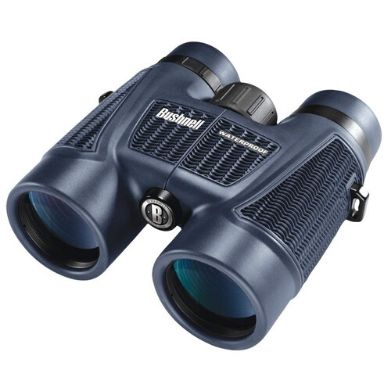
The Bushnell H20 Waterproof/Fogproof Compact Roof Prism Binoculars are some of the best compact binoculars for under $100. As a complete package, they get our choice for best value.
These binoculars have a compact design that has aged well over the decades since it was introduced. They are lightweight and practically fit into one hand. They are easy to adjust, even by people with smaller hands and fingers. They’re also designed to endure harsh weather conditions and have a non-slip rubberized outside to make sure they don’t slip out of your hands when wet.
Don’t expect these to compete against bigger models that cost more money. That savings comes from somewhere and for optics that invariably means sacrifices in imaging. They’re also not as comfortable when you’ve got your eyes to them.
- Great value
- Easy to use
- Well constructed
- Super portable
- Not very comfortable
- Images not quite up to snuff
5. Celestron 71406 Small Binoculars
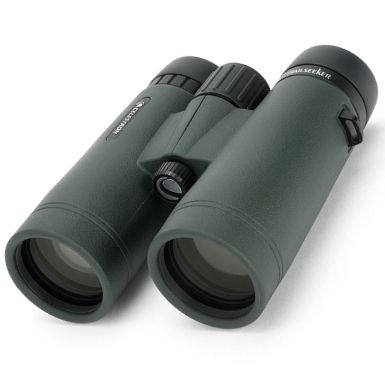
If you were to design and build a set of binoculars that produced great images but sort of forgot about everything else, the model you’d come closest to making is Celestron’s 71406 TrailSeeker.
They have one of the widest fields of view in their class of binoculars but come with multi-coated lenses that ensure that there is no decline in sharpness even out along the fringes. It’s all crisp and clean. They also come in a lightweight alloy frame that can take some significant punishment without damaging the internal components.
Unlike some of its competitors, this one doesn’t come with a hardened rubber coating to help it stay non-slip when wet and to help absorb a bit of damage. They’re also hard to focus, and because there’s a premium on the optics they come at a premium price.
- Large field of view
- Sharp images
- Lightweight, strong frame
- Expensive
- Hard to focus
6. Leica Ultravid Compact Binocular

Of all the compact binoculars we looked at, Leica’s Ultravid BRs stood out as the best for low-light conditions. They take in a lot of light and turn that into crystal clear images in overcast weather or at the beginning or end of the day.
They’re also among the lightest we looked at, weighing in at just over half a pound. Fold them in and they easily fit into most people’s hands.
For all that, they have some pretty significant knocks against them. The first is its price. These are the most expensive compact binoculars we looked at. They cost a lot, but they also can’t take a lot of punishment. When it comes to adjusting them, the diopter – the feature that helps bring both lenses to the same level of focus – sticks in place.
- Lightweight and compact
- Superb optics
- Great at gathering light
- Super expensive
- Not very durable
- Diopter sticks
7. Wingspan Compact Binoculars
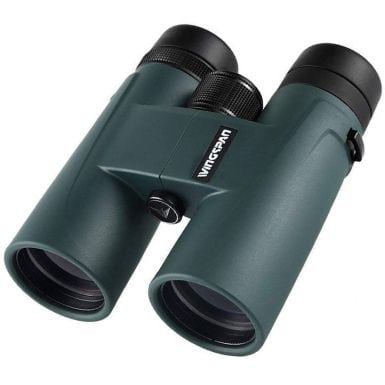
Wingspan Optics has a reputation for top-shelf optics and its WideViews HD 8×42 are a great example of why. They come with all the latest features when it comes to optics, from coated high-quality prisms to high-definition lenses. If you are into birdwatching, you’ll love all this and the wide field of view, which will help you spot new and interesting avian friends at distances.
This is all available at a pretty reasonable price. They aren’t the cheapest compact binoculars, but they offer a lot of value for what they cost.
Considering all that, these stretch the definition of “compact”. The frame isn’t all that big, but they do weigh more than other binoculars. Compared to other models within this class, they can weigh up to three times as much.
- Great imaging
- Decent value
- Designed for birdwatching
- On the heavy side
- Not on the compact side
8. Kevenz Compact-Binoculars

The Kevenz 10×42 Compact Binoculars are not the most affordable compact binoculars that we looked at, but we feel these offer at least some balance of affordability and performance to make them worth looking at.
They combine the latest optics features like multi-coated lenses and high-quality prisms to deliver imaging that is decent enough to be worth the investment of what they cost.
On the downside, the Kevenz are advertised as waterproof, but they aren’t. If you submerge them entirely in water, some might seep in. They also don’t have low-light features as marketed.
- Very affordable
- Decent imaging
- No low-light features
- Not waterproof
- Bit on the heavy side
9. Aurosports High-Powered Binoculars
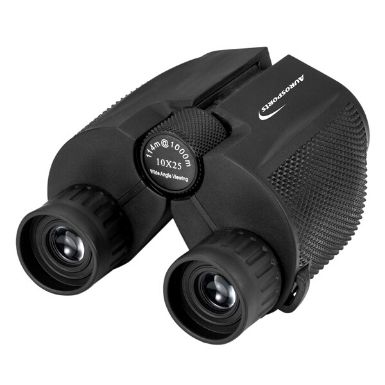
There is one thing the Aurosports 10×25 Folding High Powered Binoculars aren’t and that is high powered. Sure, they can just say they are high powered, but the optic quality just isn’t there to support the claim.
What they are is very affordable. They are the most inexpensive binoculars we looked at. We also think they look kind of cool, almost as if they’re from a science fiction movie set. That’s also the problem. They look, and even function, as if they’re a prop. The imaging just isn’t all that good, despite how they are advertised.
- Very affordable
- Looks cool
- Subpar imaging

Buyer’s Guide: Finding the Best Compact Binoculars
Shopping for any kind of optics can be fraught with challenges. Binoculars are by their nature somewhat complicated. Few people put the time into learning about optics so they understand how they are constructed, and how something that is 1,000 yards away can be made to look like it is right next to you.
In this buyers’ guide, we broke down what the different terms used in shopping for binoculars mean and how they can help guide you in making the right choice.
Magnification and objective lens size
Binoculars have what looks like a multiplication problem. As an example, we’ll use our Top Pick – the Zeiss 8×25 Terra. The “8×25” is not an equation with a total product of 200; it’s two measurements put together.
The first one is 8x, which is the magnification. The image you see through these binoculars is eight times what it is to the naked eye. It’s that straightforward. The magnification helps you understand how much detail the binoculars will help recreate for you, but bigger isn’t always better. At higher magnifications, the natural movements of your body will cause the binoculars to move around, making the images shakier. Generally speaking, a magnification of eight is considered just about ideal for bird watching.
The second is just as straightforward, but it’s less simple. It is the measurement, usually in millimeters, of the objective lens, which is the lens furthest from your eyes. In his case, these binoculars have a magnification of eight and the objective lens is 25 mm in diameter.
This tells you two things. The first is that the objective lens of binoculars can go up to 50mm and higher. So, an objective lens of 25mm is pretty compact, which is what you’re looking for. The second thing that it tells you is how much light it allows in. The more light it allows in, the better the binoculars will perform in low-light conditions. So, these Zeiss binoculars are pretty compact, but won’t be great at dusk.
Somewhat related to this number is the field of view. You’ll need to look at a set of binoculars’ specifications for this, but it’s expressed as the side-to-side field of view expressed in either feet or meters at 1,000 feet or meters. Common fields of view are somewhere between 310 and 340. That is, for example, 338 feet at 1,000 feet.
Let’s talk lenses
There are two sets of lenses. As we mentioned, the objective lens is the set that is furthest from the eyes. The one closest to the eyes is called the ocular lenses. You can also call them the eyepieces. These lenses are made of specially constructed glass designed to help magnify what you’re looking at.
Because each color of light travels at slightly different speeds (red light, the shortest within the light spectrum, is the fastest; while violet, the longest on the visible light spectrum, travels the slowest) when the lenses produce an image it can create distortions by these different travel times. These distortions are called chromatic aberrations.
To correct these distortions, makers of binoculars have started coating their lenses with materials so the light is collected and processed all at the same time. This produces images free of chromatic aberrations. The lenses can also be made from a glass called extra-low dispersion (ED) glass that irons these out.
These features used to be expensive and found only in expensive binoculars. These days, they’re pretty common for binoculars at every price range. Just be aware that lenses made of ED glass are usually better than coated lenses and that some coated lenses perform better than others.
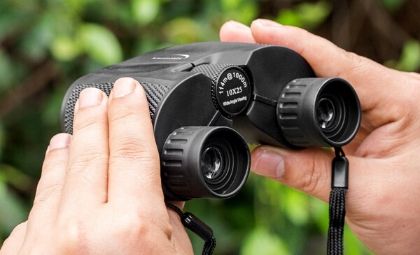
Prisms
If binoculars processed images between the two sets of images, what you see through the eyepiece would be upside down and backward. As a result, binoculars channel their imagines through internal prisms.
There are two kinds of prisms, Porro and roof. Porro prisms are most commonly found in older style binoculars and send the image the length of the prism before making a 90-degree turn into another prism, where it’ll make another 90-degree turn and go through the ocular lens.
While these look old-timey and don’t give the impression of being high quality, at lower prices they still compete with the other kind, which is roof prisms.
Roof prisms aren’t prisms that are mounted to the roof of the binoculars. They are advanced prisms shaped like the pitched roof of a house. These binoculars tend to be more compact in shape. If you’re looking for a compact set of binoculars, chances are you’ll want one with roof prisms. They are also a little more expensive, have a slightly smaller field of view, and let a little less light in the objective lens.
Body construction
Roof prisms have one more advantage. They tend to be a little more durable. That’s great if you use them for outdoor activities like hunting or hiking. You’ll want to look for binoculars designed for the conditions you’ll use them in. If you’re sitting them on your back patio to check out a bird feeder, they don’t need to be so rugged. If you’re hauling them around to hunt elk at the horizon, you’ll want them made of somewhat sterner stuff.
One thing you’ll want to look for is whether the binoculars you’re checking out are gas sealed. These are binoculars for which the oxygen has been pumped from the main chamber and replaced with an inert gas like nitrogen or argon. This gas will help keep water vapor from seeping in and fogging up your lenses from the inside.
If you plan to use your binoculars in the rain or where you might drop them in a puddle, creek, or pond, make sure they’re waterproof rather than water-resistant.
Finally, a good outer coat will help keep the water out of your binoculars. It’ll also protect them in case you drop them. It’ll also help you keep hold of them if they get wet.
The little extras
We like our binoculars to require a bit of a firm push to adjust the center focus. If it’s too loose, they can get knocked out of alignment by a soft bump. That goes for the diopter adjustment usually on the right eyepiece. This allows you to make sure that your right eye and left eye, one of which is usually stronger than the other, both see the same things at the same focus.
Most sets of binoculars will come with a carrying case, a neck strap, a wiping cloth, and lens caps. We don’t typically allow these accessories to serve as any kind of make-or-break. You can always get new ones and these are things included mostly because people would complain if they weren’t.
Price
You don’t need to spend an arm and a leg to get a good set of binoculars anymore. That’s a good thing because if you use them outdoors you run the risk of losing them. So, make sure when shopping for them what you need out of your binoculars and then determine how much money you can afford to lose if they fall from your pack while you aren’t looking.

Conclusion
Through our reviews, the Zeiss 8×25 Terra ED Compact Pocket binoculars were the best compact binoculars and our Top Pick. They excelled in everything you’d want, and do it in binoculars that weigh little enough that you might forget you’re carrying them. They are expensive, however. The Vortex Optics Diamondback Compact got our nod for Best Hunting Binoculars. They combine great images with a longer range in a non-slip rubber armor frame that withstands the elements and won’t wear you out packing them around. They’re designed for hunting at longer ranges, so if you need something to scan a field in close, these are more binocular than you need. Nikon’s reputation for making great optics is well warranted with the 16000 PROSTAFF 7S. The images aren’t perfect, but they are very good and the rest of this set’s features more than make up for it. The Bushnell H20 Waterproof/Fogproof Compact Roof Prism Binoculars are our pick for best value. They’re great compact binoculars for under $100, but don’t expect them to compete against the bigger dogs for quality or comfort in use. Celestron’s 71406 TrailSeeker is all about the optics. They create great images but retain sharpness in a wide field of view. However, they are expensive and hard to focus.
The Leica Ultravid is a very expensive set of binoculars that offers great optics and superb light gathering for low-light viewing. They aren’t very durable and we don’t like the diopter adjustment, though. The Wingspan Optics WideViews offer great imaging for a pretty reasonable price. We just think the total package pushes the envelope on what most people would consider as compact. The Kevenz 10×42 Compact Binoculars start moving us towards the basement in terms of price but provide a little more value when it comes to imaging features. The Aurosports 10×25 Folding High Powered Binoculars are cheap and attractive, but they just can’t deliver where it most counts, and that’s in optics.
Other useful posts:
- Which zoom binoculars perform the best? We decided to take a look
- Which binoculars work best for attending a concert?
Featured Image Credit By: Binocular Eschenbach, Wikipedia
Table of Contents
- Comparison of our Favorites (Updated in 2025)
- The 9 Best Compact Binoculars
- 1. Zeiss Terra 8×25 Compact Binoculars – Best Overall
- 2. Vortex Diamondback Compact Binocular – Best for Hunting
- 3. Nikon PROSTAFF 7S Compact Binoculars
- 4. Bushnell H20 Compact Binoculars – Best Value
- 5. Celestron 71406 Small Binoculars
- 6. Leica Ultravid Compact Binocular
- 7. Wingspan Compact Binoculars
- 8. Kevenz Compact-Binoculars
- 9. Aurosports High-Powered Binoculars
- Buyer’s Guide: Finding the Best Compact Binoculars
- Conclusion
About the Author Robert Sparks
Robert’s obsession with all things optical started early in life, when his optician father would bring home prototypes for Robert to play with. Nowadays, Robert is dedicated to helping others find the right optics for their needs. His hobbies include astronomy, astrophysics, and model building. Originally from Newark, NJ, he resides in Santa Fe, New Mexico, where the nighttime skies are filled with glittering stars.
Related Articles:
How to Collimate Binoculars: 9 Expert Tips
When Were Binoculars Invented? History, Today & Future
How to Clean a Refractor Telescope: Step-by-Step Guide
How to Clean a Telescope Eyepiece: Step-by-Step Guide
How to Clean a Rifle Scope: 8 Expert Tips
Monocular vs Telescope: Differences Explained (With Pictures)
What Is a Monocular Used For? 8 Common Functions
How to Clean a Telescope Mirror: 8 Expert Tips



